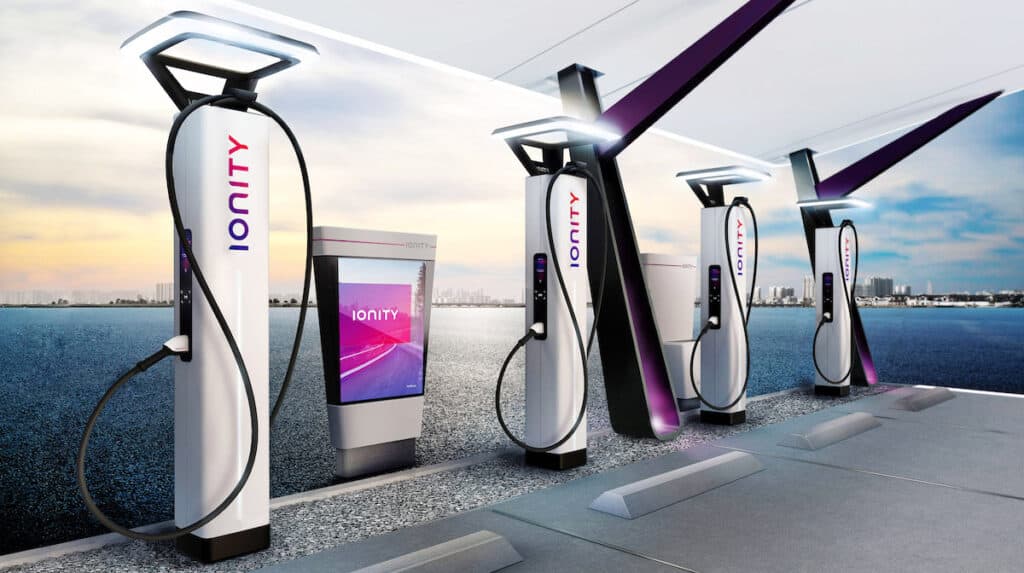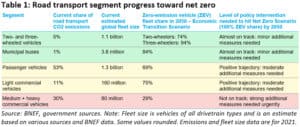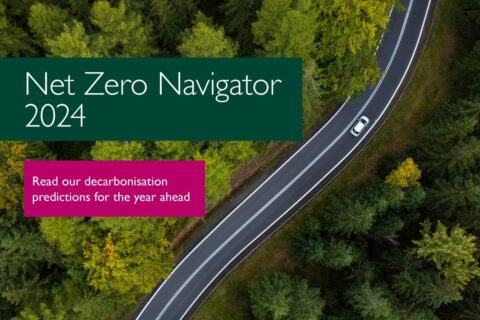
The road transport sector can still reach net-zero emissions by 2050 through electrification, but urgent action is required from policymakers and industry participants, especially on commercial vehicles. Achieving a green global fleet would also require the last internal combustion vehicle to be sold by 2038, says leading annual report.
According to the latest Long-Term Electric Vehicle Outlook (EVO) from BloombergNEF (BNEF), certain segments, such as buses and two- or three-wheelers are close to being on track for net zero, but there is no room for complacency and more action is needed elsewhere – especially in medium and heavy commercial vehicles.
There is still hope, but time is short, says Aleksandra O’Donovan, head of electric vehicles at BNEF:
“The window to stay on track for net-zero road transport emissions by 2050 is still open — but only just barely. A big push is needed from governments, automakers, part suppliers and charging infrastructure providers.”
A tale of two scenarios and the end of oil demand
The Long-Term EVO outlines two scenarios for the uptake of electric transport to 2050, and examines impacts on demand for batteries, materials, oil, electricity, infrastructure and emissions.
The Economic Transition Scenario (ETS), which assumes no new policies and regulations are enacted, is primarily driven by techno-economic trends and market forces.
The second scenario investigates what a potential route to net-zero emissions looks like for the road transport sector by 2050. This Net Zero Scenario (NZS) focuses primarily on economics as the deciding factor for which drivetrain technologies are implemented to hit the 2050 target.
Passenger electric vehicle (EV) sales are set to grow rapidly in the next few years, rising from 6.6M sold in 2021 to 21M in 2025. The fleet of EVs on the road hits 77M by 2025 and 229M by 2030, based on the BNEF ETS. Up from 16M at the end of 2021, that is reflective of the remarkable success story of EVs in the energy transition to date.
As EV uptake continues to grow, they are already displacing 1.5M barrels of oil demand per day. Most of this is from electric two- and three-wheelers in Asia, but rising passenger EV sales push this to 2.5M barrels per day by 2025.
Overall, oil demand from road transport is now set to peak by 2027, according to BNEF, as electrification spreads to all other areas of road transport beyond passenger cars. Sales of internal combustion engine vehicles already peaked in 2017 and BNEF expects the global fleet of ICE passenger vehicles to start to decline in 2024.
To get on track for a net-zero global fleet by 2050, zero-emission vehicles need to represent 61% of global new passenger vehicle sales by 2030, 93% by 2035, and the last ICE vehicle of any segment needs to be sold by 2038.
The report also found that vehicle-to-grid (V2G) technology can play a role in driving down power sector emissions and generating value for consumers.
EVs are a powerful tool in reducing global CO2 emissions from the transport sector, but the call to action is urgent, says Colin McKerracher, head of the advanced transport team at BNEF and lead author of the report:
“There are very positive signs that the market is moving in the right direction, but more action is needed – especially when it comes to heavy trucks. Action also needs to focus on emerging markets, which need financial support to help enable and accelerate the transition to electric mobility of all types.”
Prospects for growth broken down by transport segment
According to BNEF, developed countries and multilateral institutions should include electric vehicle investments, incentives and charging infrastructure deployments in their international climate finance plans, making capital available to emerging economies with credible proposals in place.
Concessional finance has been a key enabler for the development of renewable power generation in emerging economies and could play a similar role in the EV sector.
In terms of the two scenarios, the fleet of passenger electric vehicles is set to hit 469M in 2035 in the ETS but needs to jump up to 612M by the same date in the NZS. Much of the gap will have to be met in emerging economies, while wealthy countries should look at ways to support the transition in those markets and avoid a global slowdown of adoption.

Looking at different segments, two- and three-wheelers and buses are already very close to the trajectory needed to achieve BNEF’s NZS. However, medium and heavy commercial vehicles are lagging far behind, and need strong additional policy measures to meet net zero. Under the Economic Transition Scenario, only 29% of these vehicles achieve zero emissions by 2050 – far from the full adoption needed for net zero.
In addition to tighter fuel economy or CO2 standards for trucks, governments may need to consider mandates for the electrification of fleets, including those of governments and transport operators.
Governments should also consider zero-emissions zones in cites, and incentives to push freight into smaller trucks which can electrify faster than larger ones.
Batteries, or fuel cells, in the long-haul?
The report also explores whether batteries or fuel cells are the more likely solution for heavy-duty, long-haul freight. By the end of the 2020s, megawatt-scale charging stations, as well as the emergence of higher energy density batteries, will result in battery-electric trucks becoming a viable option for heavy-duty long-haul operations, especially for volume-limited use cases.
Direct electrification via batteries appears to be the most economically attractive and efficient approach to decarbonising road transport, including trucking, and should be pursued wherever possible. Hydrogen fuel cell vehicles can help fill the small gaps left by electrification in some heavy vehicles, in regions or duty cycles where batteries struggle.
The report suggests that reducing car dependence through public transport, walking, cycling and other measures should be pursued wherever possible. A 10% reduction in kilometres travelled by car by 2050 alone would lead to 200M fewer cars on the road, reducing cumulative CO2 emissions by 2.25 gigatons and alleviating strain on the battery supply chain, all of which will benefit long-term decarbonisation targets.
EV manufacturers are contemplating a market for battery raw materials that is very tight for years ahead. The battery supply chain will require significant near-term investment to avoid a crunch.
The rising cost of batteries is not, however, likely to derail near-term EV adoption. Some of the factors driving high battery raw material costs – war, inflation, trade friction – are also pushing the price of gasoline and diesel to record highs, which in turn boosts consumer interest in EVs.
The Outlook report is published every year by BloombergNEF (BNEF), a strategic research provider covering global commodity markets and the disruptive technologies driving the transition to a low-carbon economy. BNEF assesses pathways for the power, transport, industry, buildings and agriculture sectors to adapt to the energy transition.
Further Reading:
- More about BloombergNEF (BNEF), in general;
- More on the BNEF Long-Term Electric Vehicle Outlook, its executive summary and key findings;
- More on the IONITY charging network in Europe; and Octopus Energy;
- Also on SustMeme, All-electric lithium to power North America EV drive;
- Also on SustMeme, Charging ahead on the switch to electrified fleets;
- Also on SustMeme, First full-electric truck for inner-city logistics;
- Also on SustMeme, Decarbonising logistics: ‘Supply Chain Resilience’ in The Sunday Times;
- Also on SustMeme, Second-life battery solution for circular EV charging;
- Also on SustMeme, World’s first hydrogen double-decker bus unveiled in Aberdeen;
- Also on SustMeme, As EV waste looms, is Li-ion battery recycling ready to roar?
>>> Do you have sustainability news to broadcast and share? If you would like to see it featured here on SustMeme, please use these Contact details to get in touch and send us your Press Release for editorial consideration. Thanks.






